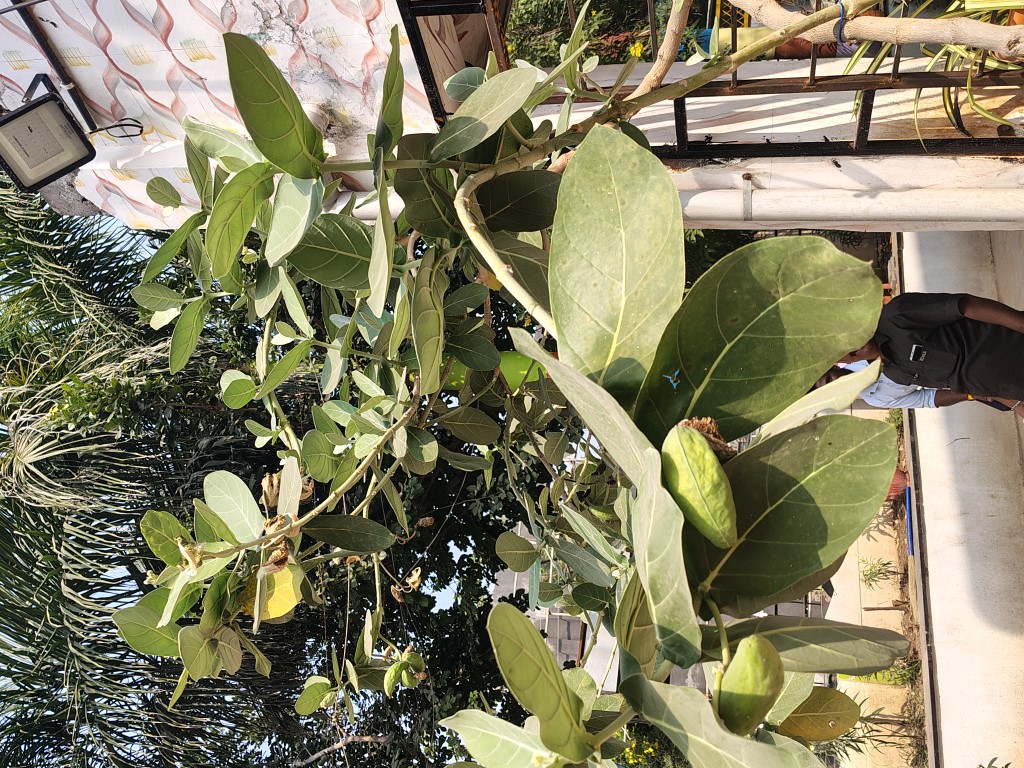Green Campus/Tree Details

रुई (Calotropis gigantea)
धोंडोळा (Calotropis gigantea)
वैज्ञानिक नाव: Calotropis gigantea
इतर मराठी नावे: कालोट्रोपिस, उंटाची कुंडी, धोंडोळा
धोंडोळा किंवा कालोट्रोपिस (Calotropis gigantea) हे एक मोठे आणि बहुउद्देशीय औषधी झाड आहे, जे भारतात आणि इतर उष्णकटिबंधीय प्रदेशांत आढळते. याला "गायंट मिल्कवीड" किंवा "क्राउन फ्लॉवर" असेही ओळखले जाते. हे झाड सामान्यतः ३ ते ४ मीटर उंचीपर्यंत वाढते आणि त्याची पाणीदार, दूधद्रव्य असलेली वनस्पती आहे, जी आपल्या विशिष्ट लक्षणांमुळे ओळखली जाते. या झाडाच्या फुलांची विशेष आकर्षकता आणि विविध औषधी गुणधर्मांमुळे त्याचा वापर विविध पारंपारिक उपचारांमध्ये केला जातो.
1. झाडाची ओळख आणि वैशिष्ट्ये (Identification and Features)
धोंडोळा झाड एक सदाहरित, मोठे आणि गुळगुळीत पानांचे असते. याची पाने मोठी आणि लांबट असतात, आणि गुळगुळीत काठ असलेल्या पानांचा रंग गडद हिरवा असतो. या झाडाचे फूल गुलाबी किंवा पांढरे रंगाचे, सुंदर आणि गोंधळलेले असतात. फुलांच्या कक्षांमध्ये शिरकाव असतो, आणि ते एकत्र येऊन एक गोलसर आकार बनवतात. याच्या फुलांचा सुगंध लहान प्रमाणात आणि मृदू असतो.
धोंडोळा झाडाच्या मुळात दूधसारखा द्रव असतो, जो साधारणतः त्याच्या प्रत्येक भागात, विशेषतः पानांमध्ये आणि फुलांमध्ये असतो. हा दूधद्रव्य अपचन, जंतुसंक्रमण, आणि इतर अनेक औषधी वापरांसाठी वापरला जातो. याच्या फुलांचा रंग आणि आकार त्याला त्याच्या सौंदर्यामुळे एक विशेष आकर्षण देतात, ज्यामुळे ते बागेतील सजावट म्हणून देखील वापरले जातात.
2. लागवडीसाठी टिप्स (Planting Tips)
धोंडोळा झाड उष्णकटिबंधीय आणि समशीतोष्ण वातावरणात चांगले वाढते. ते उष्ण आणि धूपाच्या वातावरणात उत्तम वाढते. याला पाणीचं योग्य प्रमाण हवं असतं, परंतु ओलावा साचल्यामुळे मुळांना हानी होऊ शकते. यासाठी मातीचे निचरण चांगले असणे आवश्यक आहे. झाडाच्या देखभालीसाठी सामान्यपणे प्रतिकूल हवामानाचे काळजी घेणं आवश्यक आहे, परंतु ते कमी वेळात लवकर मोठे होते.
धोंडोळा झाडास सूर्यप्रकाशाचा आवश्यकता असते, आणि ते गडद किंवा खंडित प्रकाशात असले तरीही चांगले वाढू शकतात. याचे पोषणार्थ खत व वेळोवेळी पाणी दिल्यास झाडे चांगली वाढतात.
3. औषधी गुणधर्म (Medicinal Properties)
धोंडोळा झाड आणि त्याचे विविध भाग पारंपारिक औषधी प्रणालीमध्ये मोठ्या प्रमाणावर वापरले जातात. याचे पान, फुलं आणि दूध द्रव्य याचे उपयोग विविध औषधी गुणधर्मांमुळे होतात. याच्या दूध द्रव्यामुळे जंतुसंक्रमण रोखणे, दाह कमी करणे, आणि इतर शारीरिक त्रासांवर उपचार करण्यासाठी वापरले जाते.
धोंडोळा पानांचा उपयोग विशेषतः त्वचेसाठी होतो. याचे पानांचे ताजे किंवा वाळवलेले अर्क त्वचाविकारांवर आणि जखमांवर लावले जातात. याच्या पानांचा अर्क अँटीबॅक्टेरियल आणि अँटीफंगल गुणांसाठी ओळखला जातो. याचा दूध द्रव्य पचनसंस्थेसाठी, आणि शरीरातील विविध सूजनांवर उपचार करण्यासाठी उपयुक्त ठरतो.
पेरिग्रीनच्या पानांचा अर्क सर्दी, कफ आणि ताप यावर उपचार म्हणून देखील वापरला जातो. याच्या बियांपासून आणि फुलांपासून तयार केलेल्या औषधांचा वापर पारंपारिक भारतीय औषधांमध्ये मोठ्या प्रमाणावर केला जातो.
4. विविध उपयोग (Various Uses)
धोंडोळा झाडाचा उपयोग बागकामात, औषधोपचारात आणि इतर विविध क्षेत्रांमध्ये केला जातो. याचे फूल बागेमध्ये सजावटीसाठी वापरले जातात. याच्या फुलांमुळे बागेतील आकर्षण वाढते आणि ते सुगंधी असतात.
धोंडोळा झाडाच्या दूध द्रव्याचा उपयोग पिळलेले जखमेवर उपचार करण्यासाठी, त्वचेवरील टॅटू किंवा इन्फेक्शनवर लावण्यास केला जातो. याच्या पानांचा उपयोग मसालेदार व भाज्यांच्या वाणांमध्ये केला जातो, कारण ते स्वाद सुधारण्यासाठी उपयुक्त असतात.
5. पर्यावरणीय महत्त्व (Ecological Importance)
धोंडोळा झाड पर्यावरणाच्या दृष्टिकोनातून महत्त्वपूर्ण आहे. याच्या फुलांमध्ये कीटकांचे आकर्षण होते आणि ते परागीकरण प्रक्रियेत मदत करतात. याचे विविध भाग मातीतील पोषक द्रव्य शोषून घेतात आणि त्याची प्रक्रिया मातीला पोषण देण्यात मदत करते.
6. झाडाची सजावट आणि आरोग्यदायक फायद्ये (Decorative and Health Benefits)
धोंडोळा झाडाचे आकर्षक फुल आणि मोठी पाने बागेसाठी अत्यंत सुंदर आहेत. तसेच, याचे औषधी गुणधर्म शरीरासाठी फायदेशीर असतात. झाडाचे विविध भाग आयुर्वेदात अनेक समस्यांवर उपाय म्हणून वापरले जातात.
Giant Calotropis (Calotropis gigantea)
Scientific Name: Calotropis gigantea
Common Names: Giant Milkweed, Crown Flower
Marathi Name: धोंडोळा, कालोट्रोपिस
The Giant Calotropis (Calotropis gigantea), also known as Giant Milkweed or Crown Flower, is a large, tropical plant native to Southeast Asia, India, and other parts of the world. This plant is well-known for its medicinal properties and is commonly used in traditional medicine. It is recognized for its thick, leathery leaves and unique milky sap, which has a variety of uses.
1. Identification and Features
The Giant Calotropis is a large, shrubby plant that grows up to 3-4 meters tall. The leaves are large, smooth, and green, and the flowers are typically large and showy, with colors ranging from white to light purple, often with a faint fragrance. The plant gets its name from the large, milky latex produced when the plant is cut, which is a characteristic feature of the species.
The plant's flowers are cluster-shaped, and the thick, leathery leaves help it survive in harsh, dry conditions. The latex is toxic if consumed in large quantities, and caution must be exercised when handling this plant.
2. Planting Tips
The Giant Calotropis thrives in tropical and subtropical climates. It is drought-tolerant once established and can grow in poor, dry soils. The plant requires full sunlight and benefits from occasional watering, but it is highly tolerant of dry conditions. It is usually propagated through seeds or cuttings.
While the plant can grow in almost any soil type, it does best in well-draining soil. It is essential to provide this plant with enough sunlight for optimal growth. The plant also requires a protective environment during extreme cold conditions as it does not tolerate frost.
3. Medicinal Properties
The Giant Calotropis has been used in traditional medicine for centuries. The latex and various parts of the plant are used to treat a variety of ailments. The latex has been found to have antimicrobial and anti-inflammatory properties, making it useful for treating infections, wounds, and other skin conditions.
The leaves are often used in poultices for treating fever, cough, and asthma. The plant is also known to help in digestive health and relieve constipation. However, it is important to note that the plant can be toxic if not used properly, so professional guidance is recommended when using it for medicinal purposes.
4. Various Uses
Apart from its medicinal applications, the Giant Calotropis is also used in landscaping and gardening for its striking appearance. Its large flowers and bold leaves make it a popular ornamental plant in tropical and subtropical gardens. The plant's latex is also used in the
